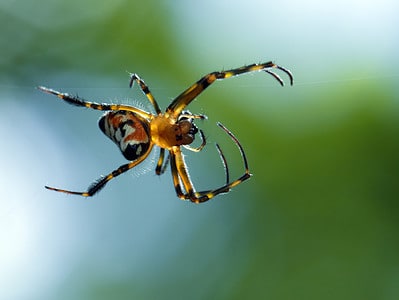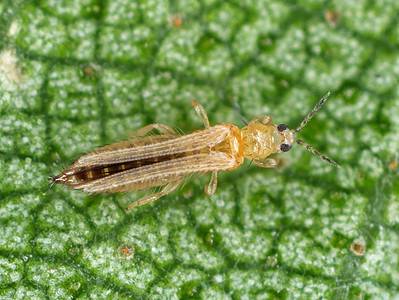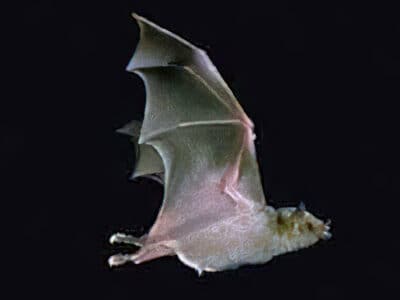Palm Rat
Rattus rattus
Domesticated house rats were bred in England during the 1920s, and one of these variations had a green-tinted fur.
Advertisement
Palm Rat Scientific Classification
- Kingdom
- Animalia
- Phylum
- Chordata
- Class
- Sarcopterygii
- Order
- Rodentia
- Family
- Muridae
- Genus
- Rattus
- Scientific Name
- Rattus rattus
Read our Complete Guide to Classification of Animals.
Palm Rat Conservation Status
Palm Rat Facts
- Prey
- Insects, small mammals and birds
- Name Of Young
- Pups
- Group Behavior
- Colony
- Fun Fact
- Domesticated house rats were bred in England during the 1920s, and one of these variations had a green-tinted fur.
- Other Name(s)
- Roof rat
- Litter Size
- 6-8 pups
- Diet
- Omnivore
- Average Litter Size
- 6-8 pups
- Lifestyle
- Colony
- Favorite Food
- seeds, fruit, stems, leaves, fungi, insects, small mammals, and birds
Palm Rat Physical Characteristics
- Color
- Black-Brown
- Age of Sexual Maturity
- 3 months
- Venomous
- No
- Aggression
- Low
View all of the Palm Rat images!
The Palm rat’s official name is Rattus Rattus, also known as the black rat, the house rat, and the ship rat. Palm rats are native to North America and tend to live in the warmer regions and more coastal parts of the country. And because distinguishing between the different types of rat species can be challenging, we use this space to describe Palm rat characteristics and behaviors.
Identifying a Palm Rat
Palm rats have scraggly, coarse fur and are often black or light brown. Their bellies are frequently lighter in comparison to the rest of their bodies. Interestingly, domesticated house rats were bred in England during the 1920s, and one of these variations had a green-tinted fur. Regarding the size of the Palm rat, the adults generally reach 5 to 7.2 inches and have tails of six to nine inches long. Adult Palm rats typically weigh between two to eight ounces. But, the black rat’s weight depends on its subspecies, with the bucks or male rats becoming heavier than the females or does.
The Difference Between a Palm Rat and a Norway Rat
Many people confuse the Palm rat with the Norway rat. However, Palm rats have thinner bodies and weigh less than Norway rats. Their tails are also a good indicator of their differences. The tail of a Palm rat is longer than its body, while the tail of a Norway rat is shorter than its body. In addition, their noses vary, with the Palm rat having a sharper nose than the Norway rat. The Palm rat’s coat is also darker than the Norway rat’s.
Habitat
Palm rats prefer living in environments with cooler weather and are known to live in colonies rather than alone. As their name suggests, roof rats are prone to climbing and living in high spaces, like roofs and attics. Although black rats prefer living in high places, they live on the ground, in garbage dumps, and under porches, if they have to. Palm rats live near densely grown areas and fruit trees in the wild.
Reproduction of the Black Rat or Palm Rat
Palm rats reproduce no matter the season. They reach sexual maturity around three months and produce a litter of five to eight rat pups. Does can birth up to five litters per year, but this depends on her surroundings. In areas where ship rats have access to food, water, and shelter, like in urban and suburban areas, they may reproduce fastly and form huge colonies in a short amount of time.
Black Rat Diet
House rats are omnivorous mammals and have adapted their diet to suit their surroundings, which means they are generalists. These rats generally eat 0.53 ounces of daily food and 15 milliliters of liquid daily. Usually, the diet of a black rat consists of seeds, fruit, stems, leaves, fungi, insects, small mammals, and birds.
Farmers and homeowners consider these rodents to be pests as they will eat the food meant for cows, swine, chickens, cats, and dogs. Besides animal feed, These rats will eat crops like cereals, sugar cane, coconuts, cocoa, oranges, and coffee beans. Additionally, these rats threaten wildlife as they hunt and feed on birds, insects, and smaller rodents.
Palm rats are also excellent foragers because they are generalists. These rats will partner with each other to forage and hunt together. They do most of their food scouring after sunset and will hide and store their finds if they can’t eat quickly enough when interrupted.
Although black, ship, or Palm rats are dietary generalists, they are also picky eaters. They choose to eat a range of dominant foods that they favor. They do this to monitor the quality of available food, such as seasonal foods, insects, and birds. Black rats also do this to maintain their nutrition intake and avoid taking in toxins due to over-eating a specific food.
House Rat Nests
Black rats favor using soft materials when making a nest. Common materials found in this rats’ nests are twigs, grasses, and other delicate plants found in the area. Ship rats also use man-made materials like shredded paper, fabric, and home insulation materials.
Diseases Carried by Ship Rats
All rats are known to be disease carriers and have caused significant loss of lives in the past when hygiene in cities was not at a premium. Today, they still introduce diseases to cities and towns throughout the world. Some of the sicknesses that Palm rats carry that can infect people include:
- Bubonic plague
- Typhus
- Weil’s disease
- Toxoplasmosis
- Trichinosis
House rats also carry a range of bacteria and viruses that can lead to humans and animals becoming infected, with some being incurable. Some of the bacterial diseases carried by these rodents are:
- Streptococcus pneumonia
- Corynebacterium kutsheri
- Bacillus piliformis
- Pasteurella pneumotropica
- Streptobacillus moniliformis
Can a Palm/Black Rat Be a Pet?
A ship or house rate can make a good pet as they are calm and peaceful. House rats are a smaller species and are perfect for holding in your hand. These rats are also playful and curious, which makes them an ideal pet for kids. Unlike many other rodent species, adult ship rats become calmer with age. They also stay healthy and are not usually prone to developing tumors or becoming obese.
Potential pet owners also need to know that Palm rats are nocturnal. This characteristic means you must place their cage in a quiet and calm space. Rat owners must also ensure their pet rats have treats and toys to chew on to grind their teeth. Since rat teeth never stop growing, they should always have something to gnaw on to ensure they remain a healthy length.
View all 192 animals that start with PPalm Rat FAQs (Frequently Asked Questions)
Where do palm rats live?
Palm rats prefer living in environments with cooler weather and are known to live in colonies rather than alone.
What do palm rats look like?
Palm rats have scraggly, coarse fur and are often black or light brown. Their bellies are frequently lighter in comparison to the rest of their bodies.
Thank you for reading! Have some feedback for us? Contact the AZ Animals editorial team.

















